RARE! WWII 1943 Operation Postern New Guinea Campaign 8th Photo Reconnaissance Squadron (5th Air Force) Heavily Used Finschhafen & Kedam Point Combat Aerial Photo Map
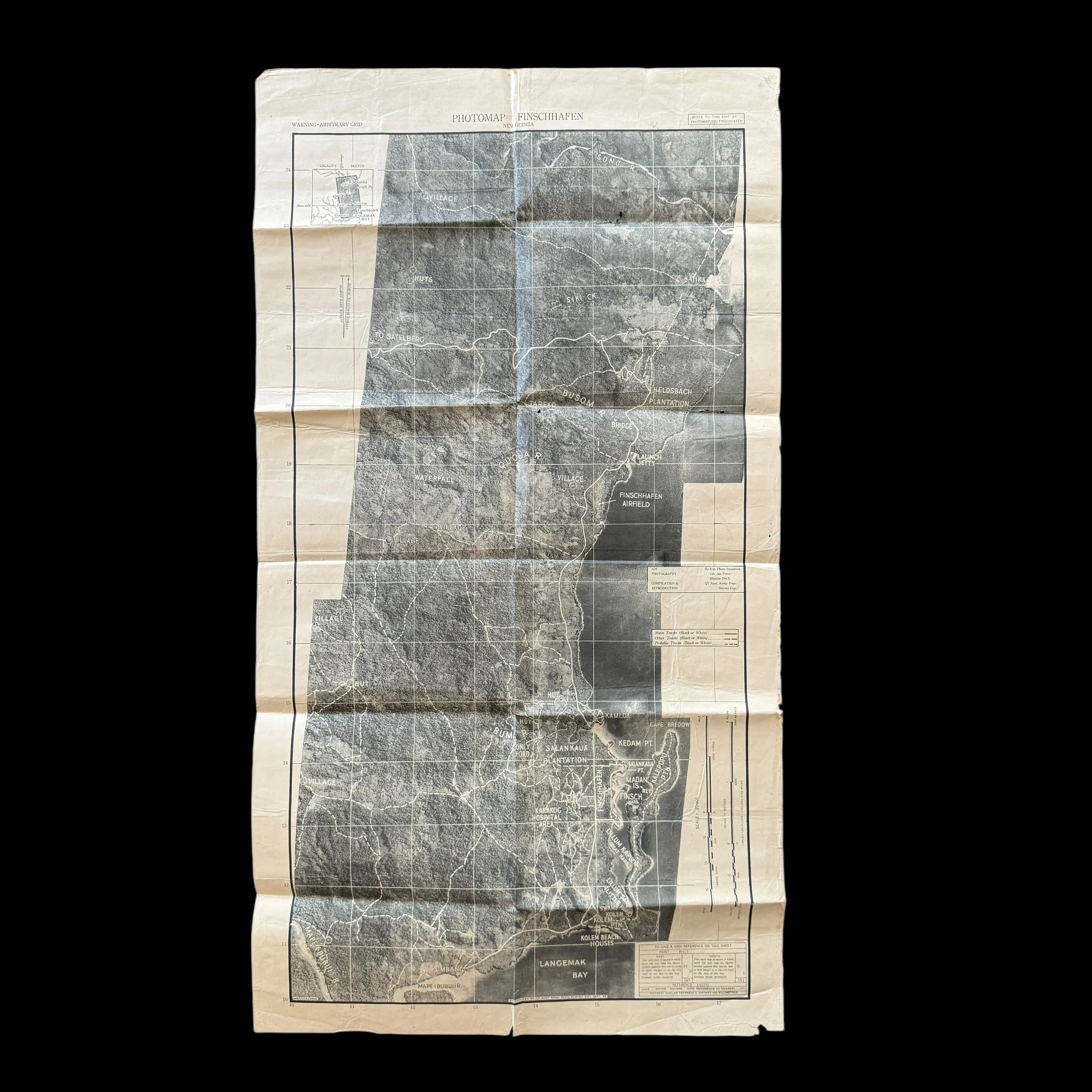
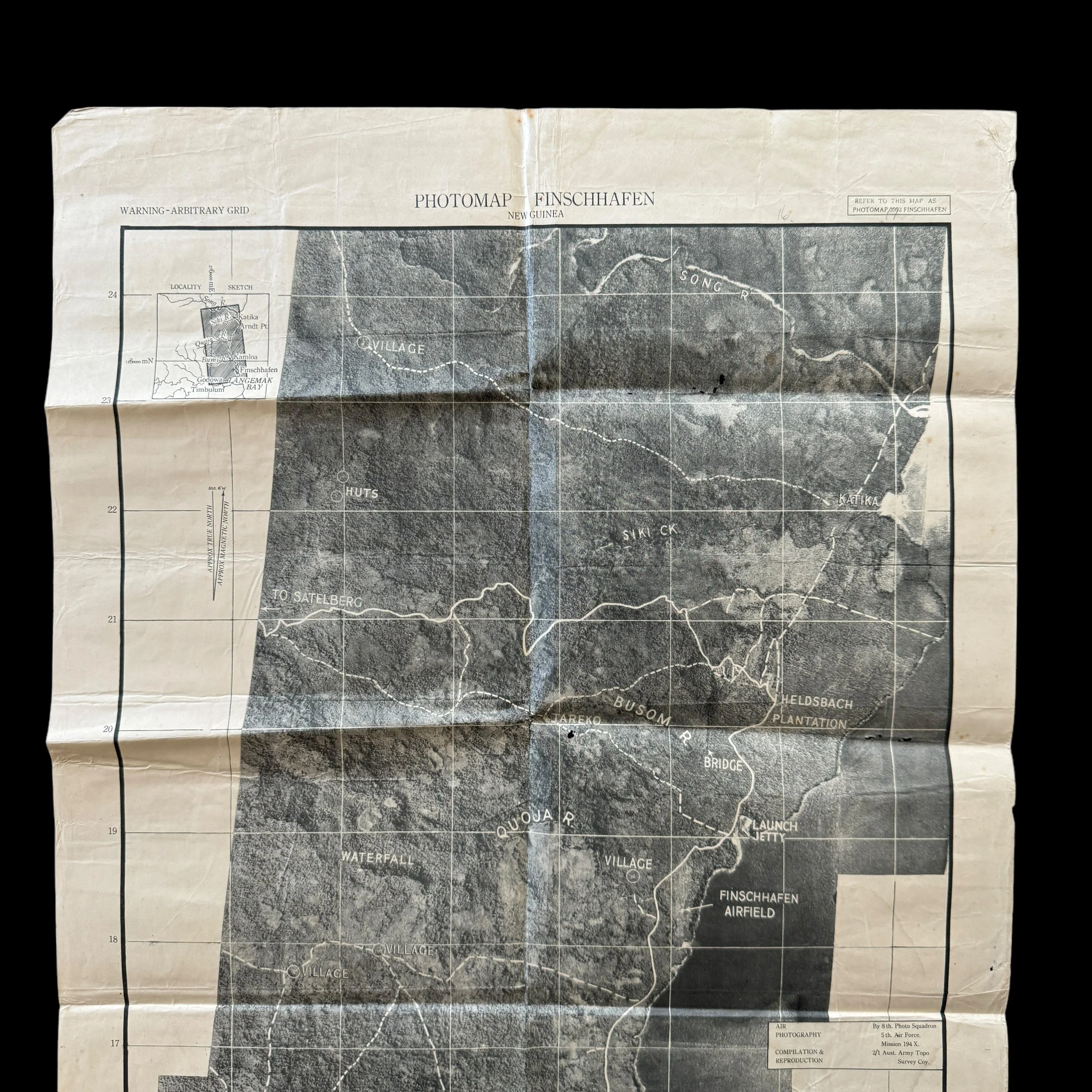

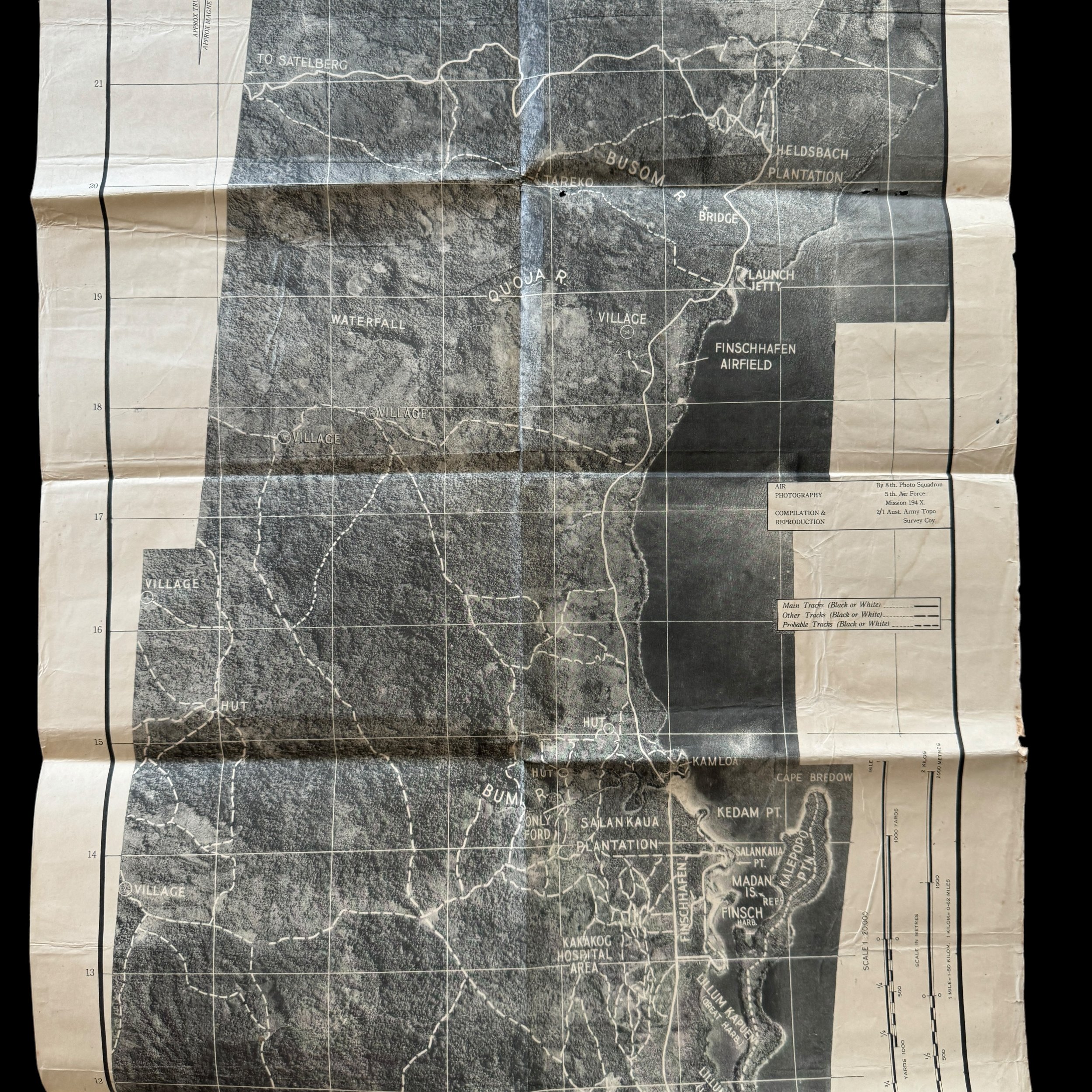


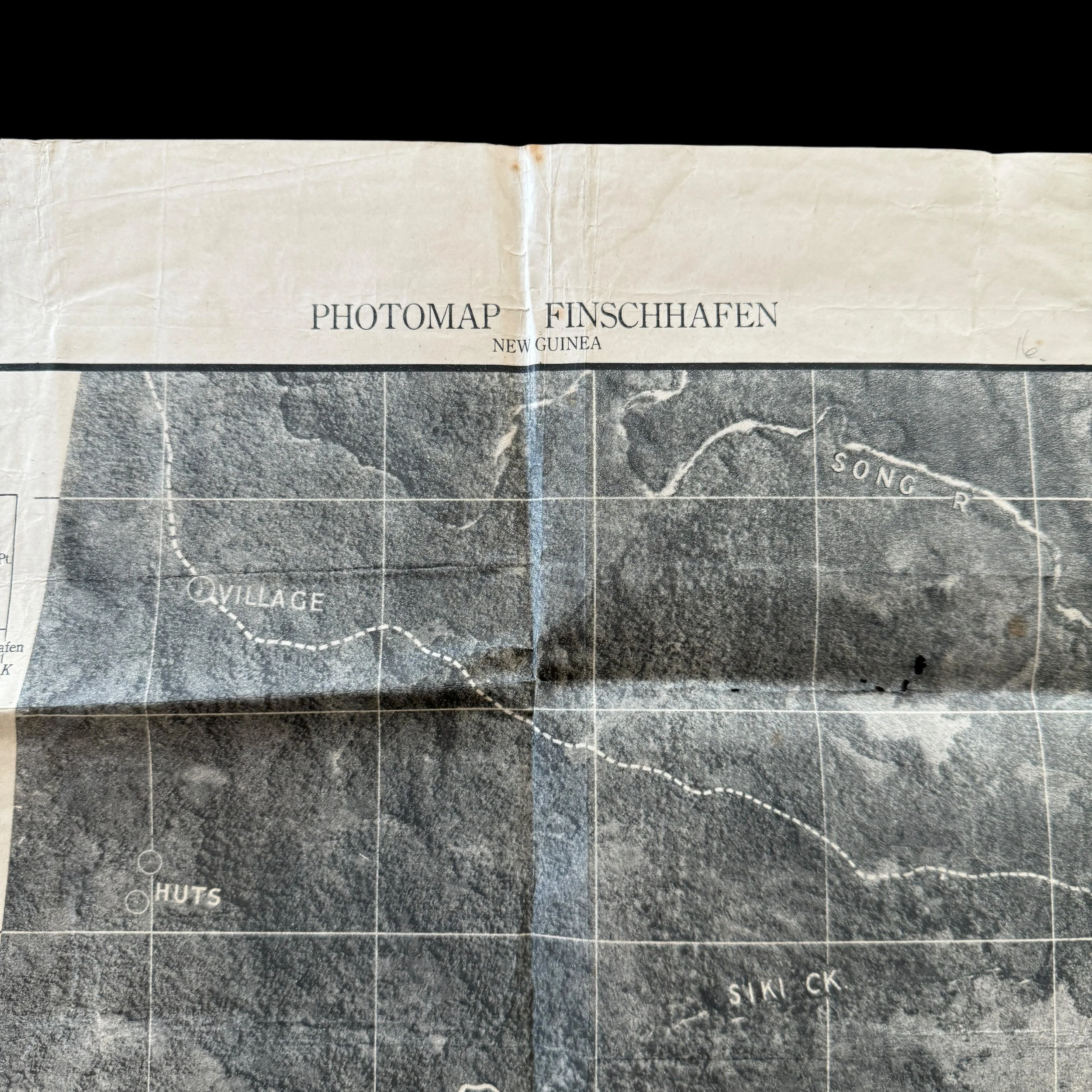
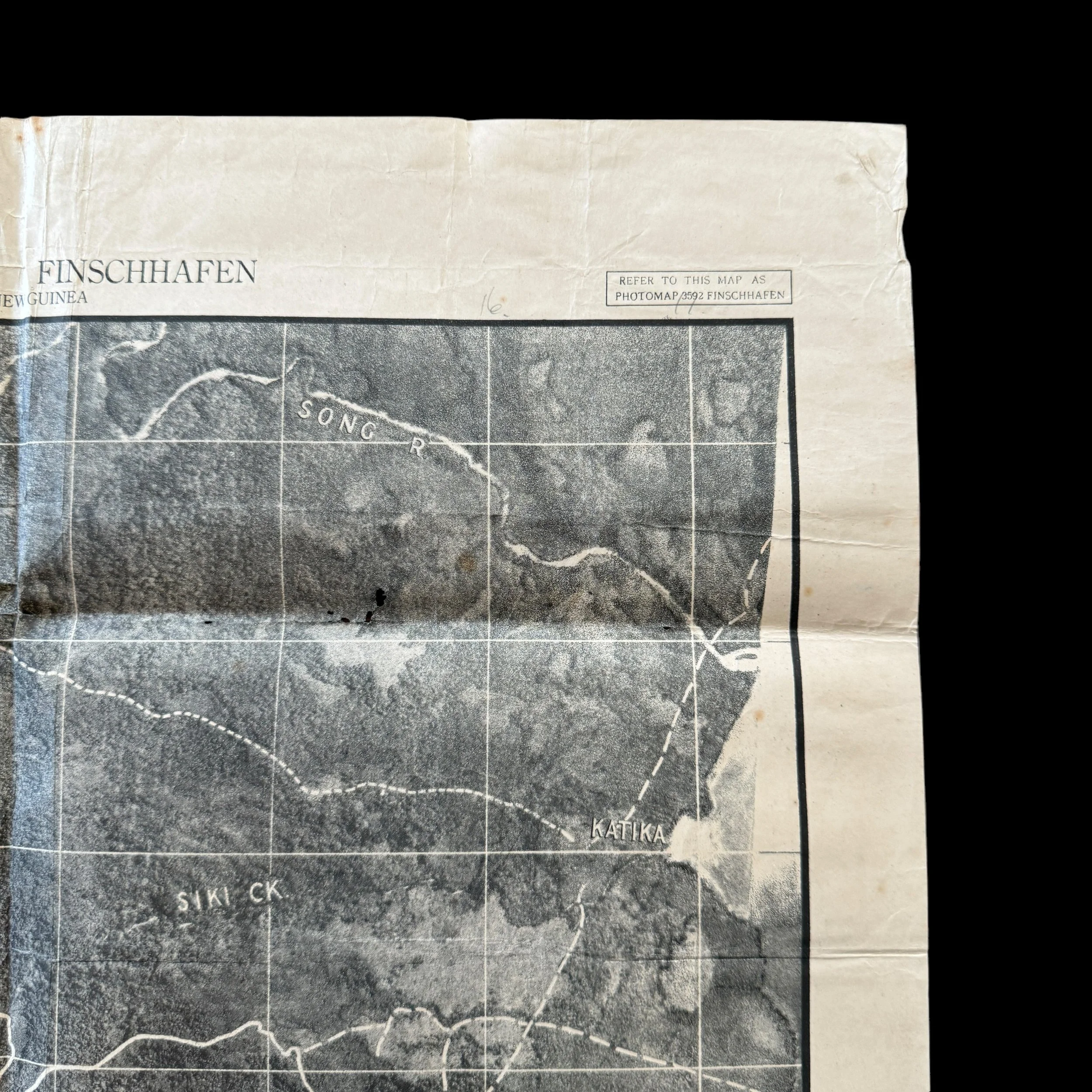
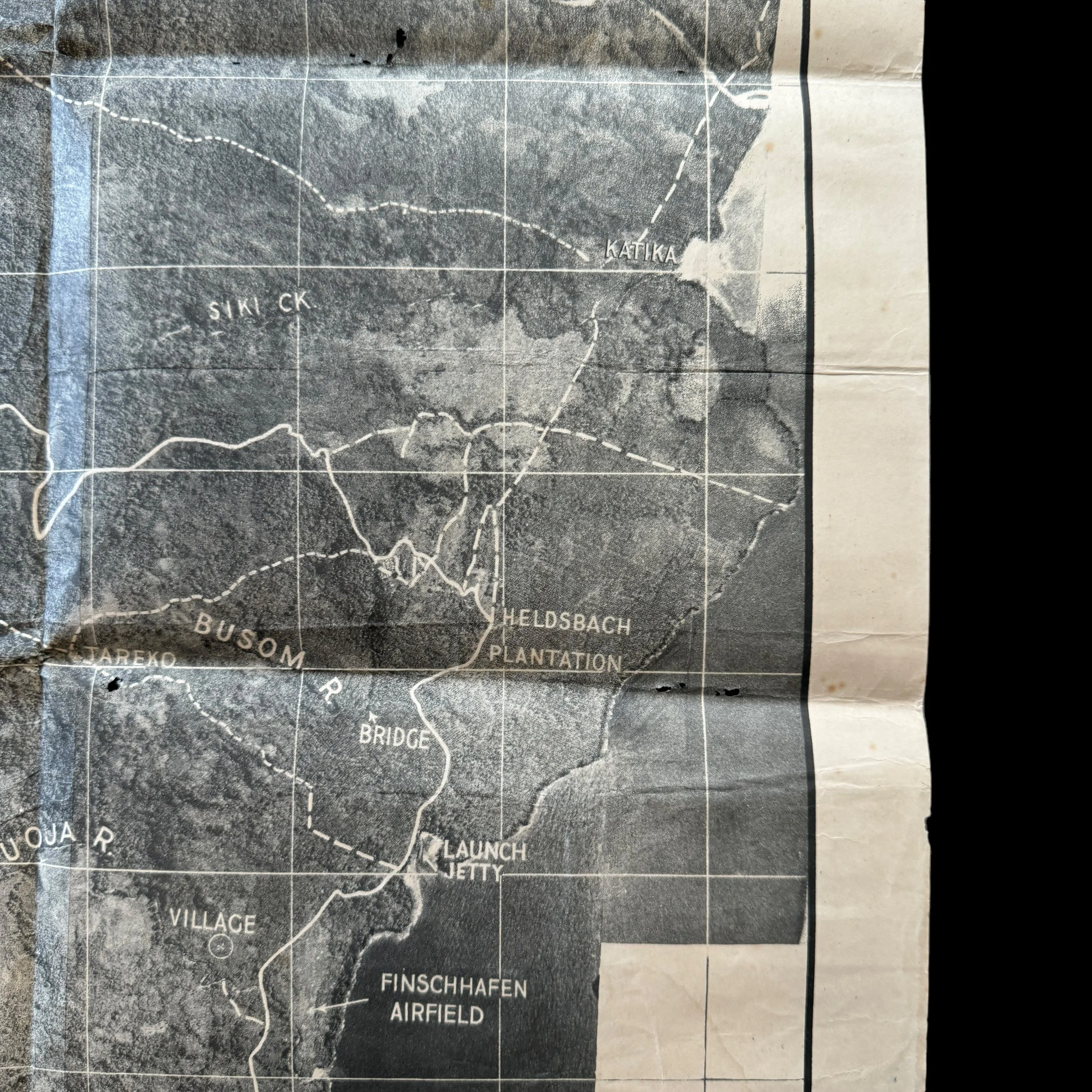
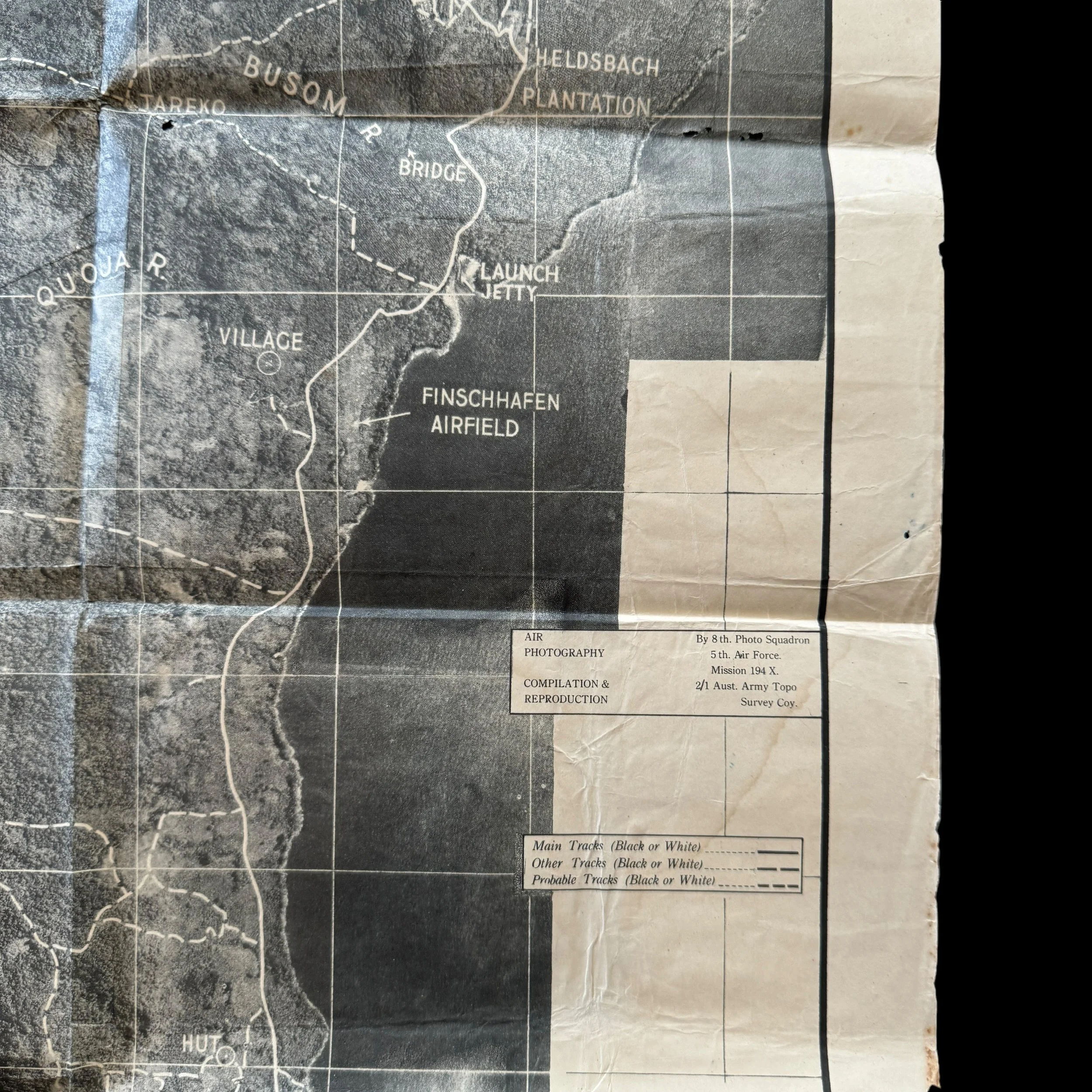
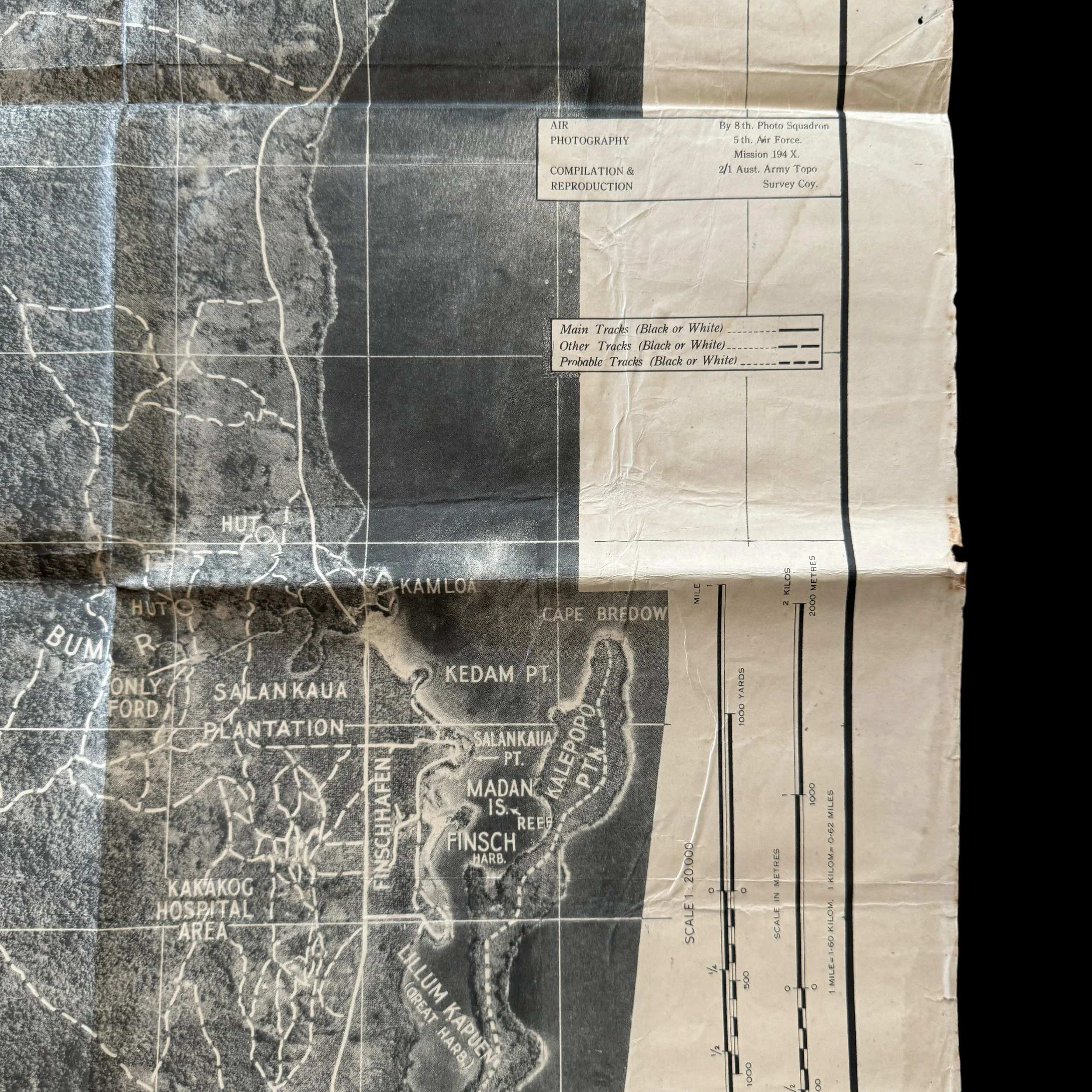
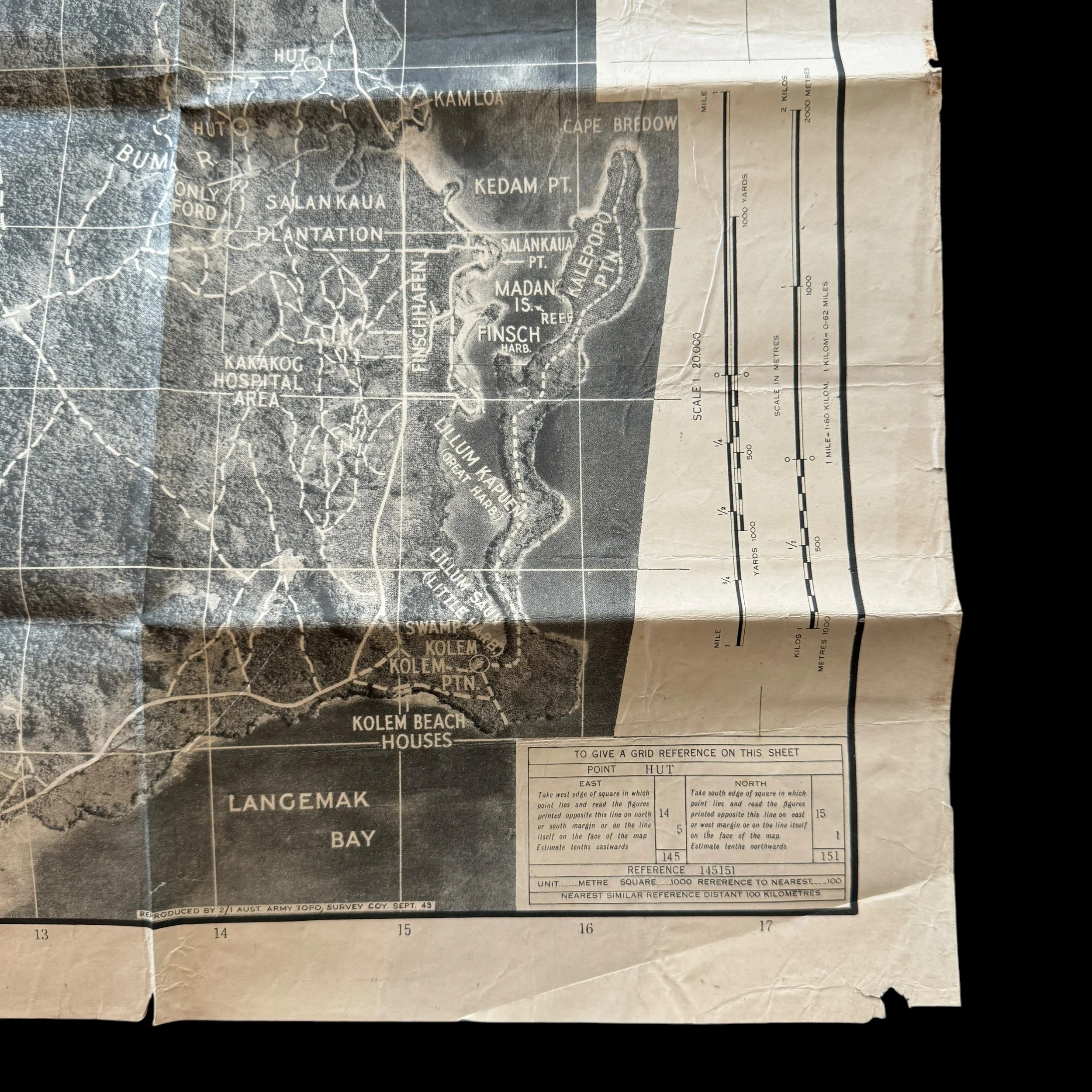


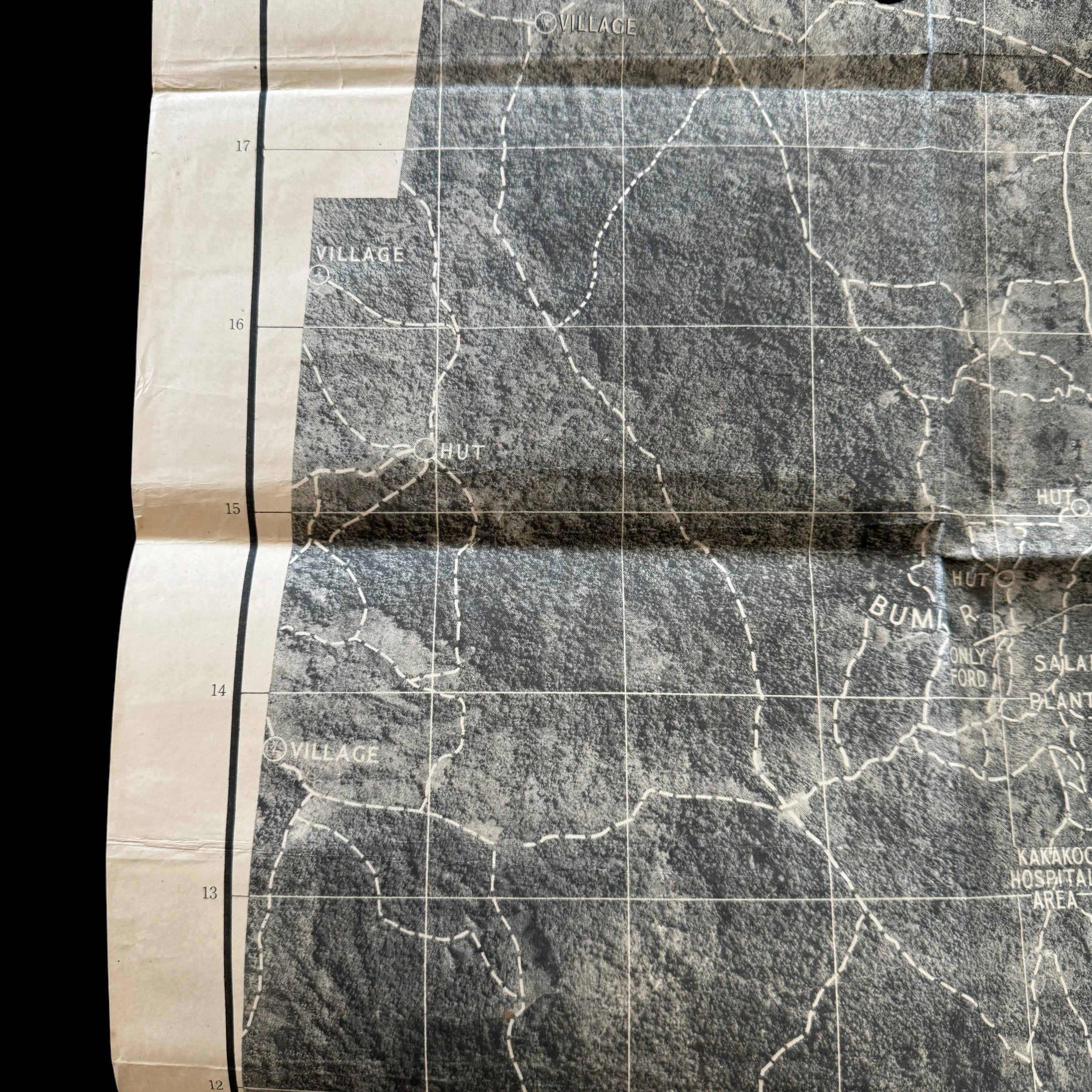
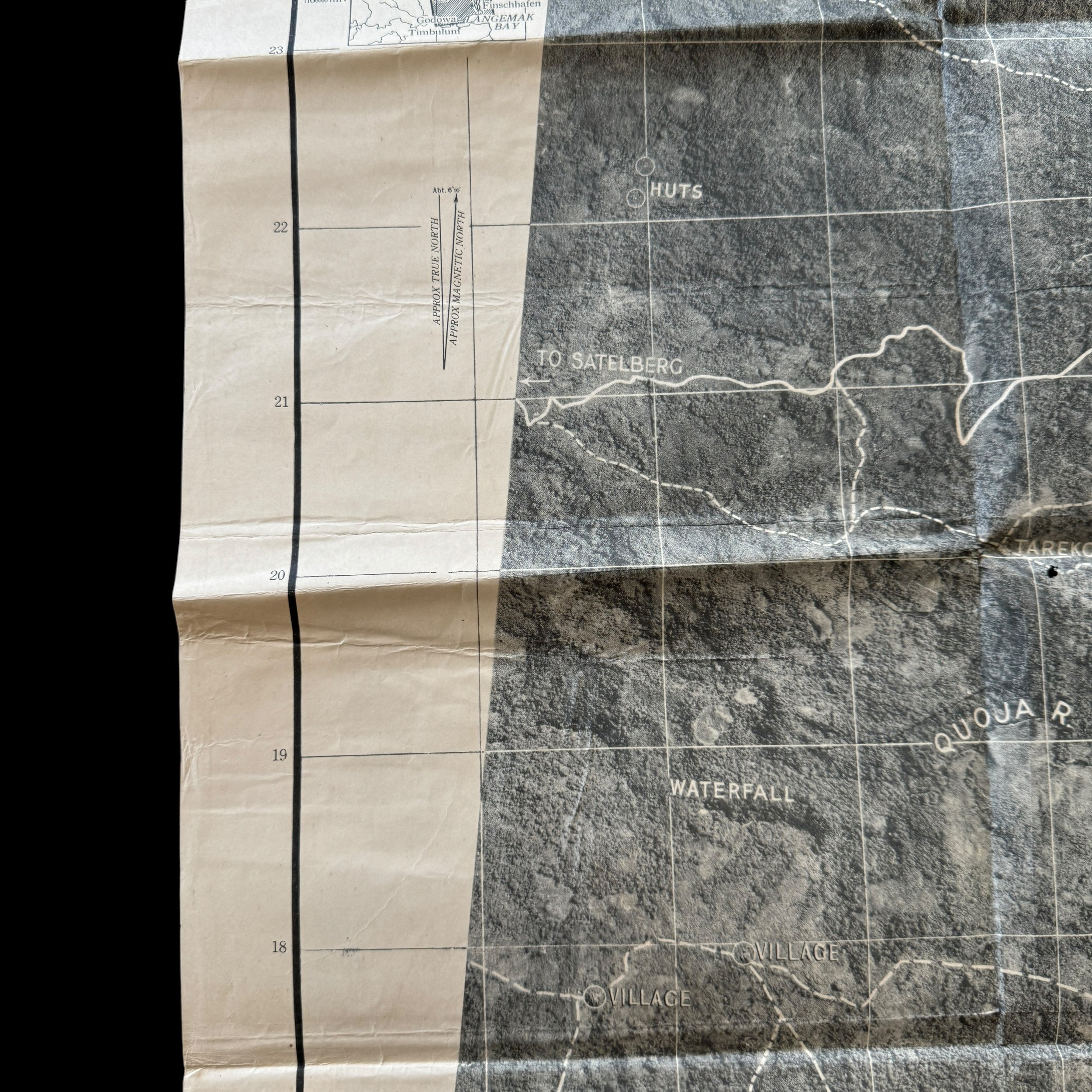
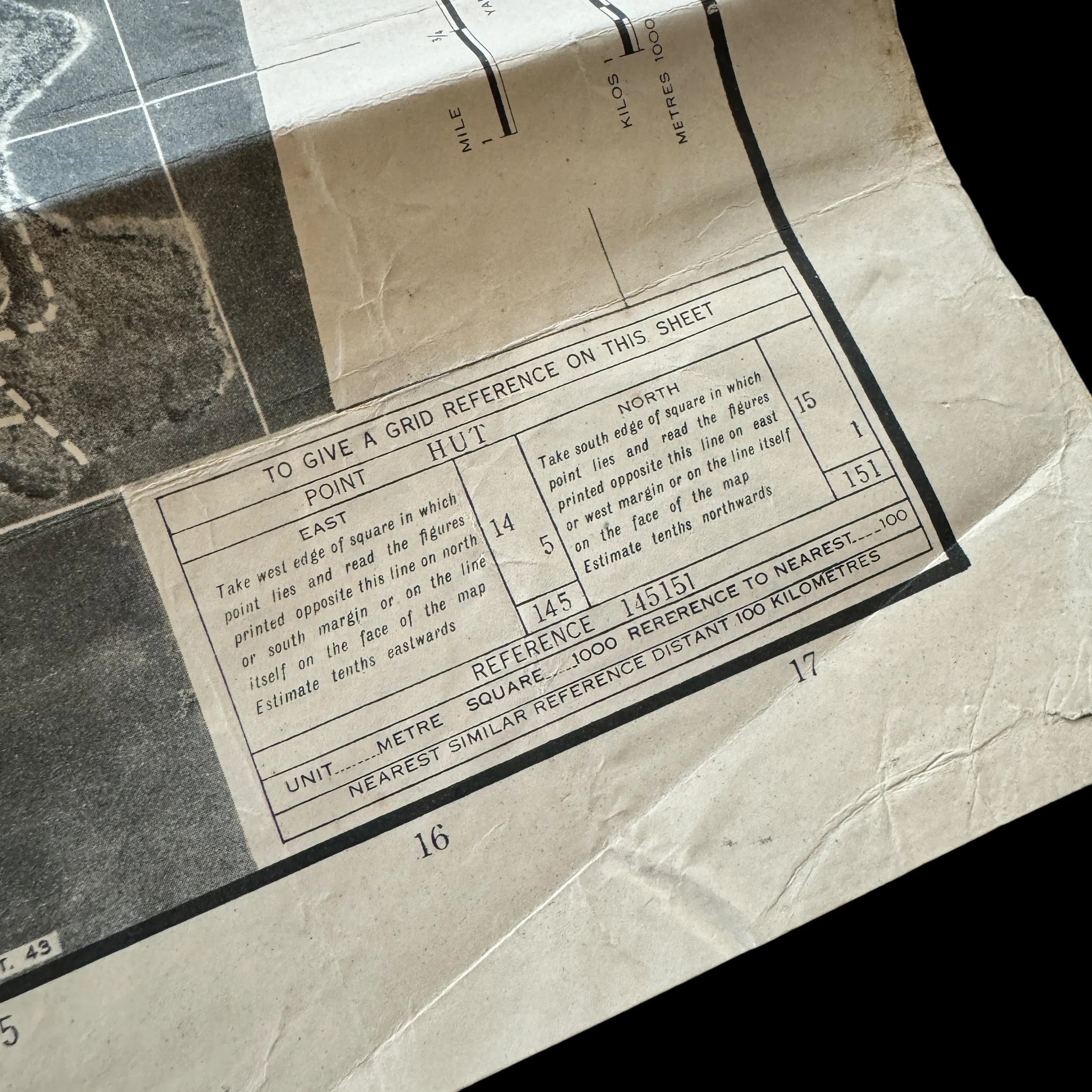
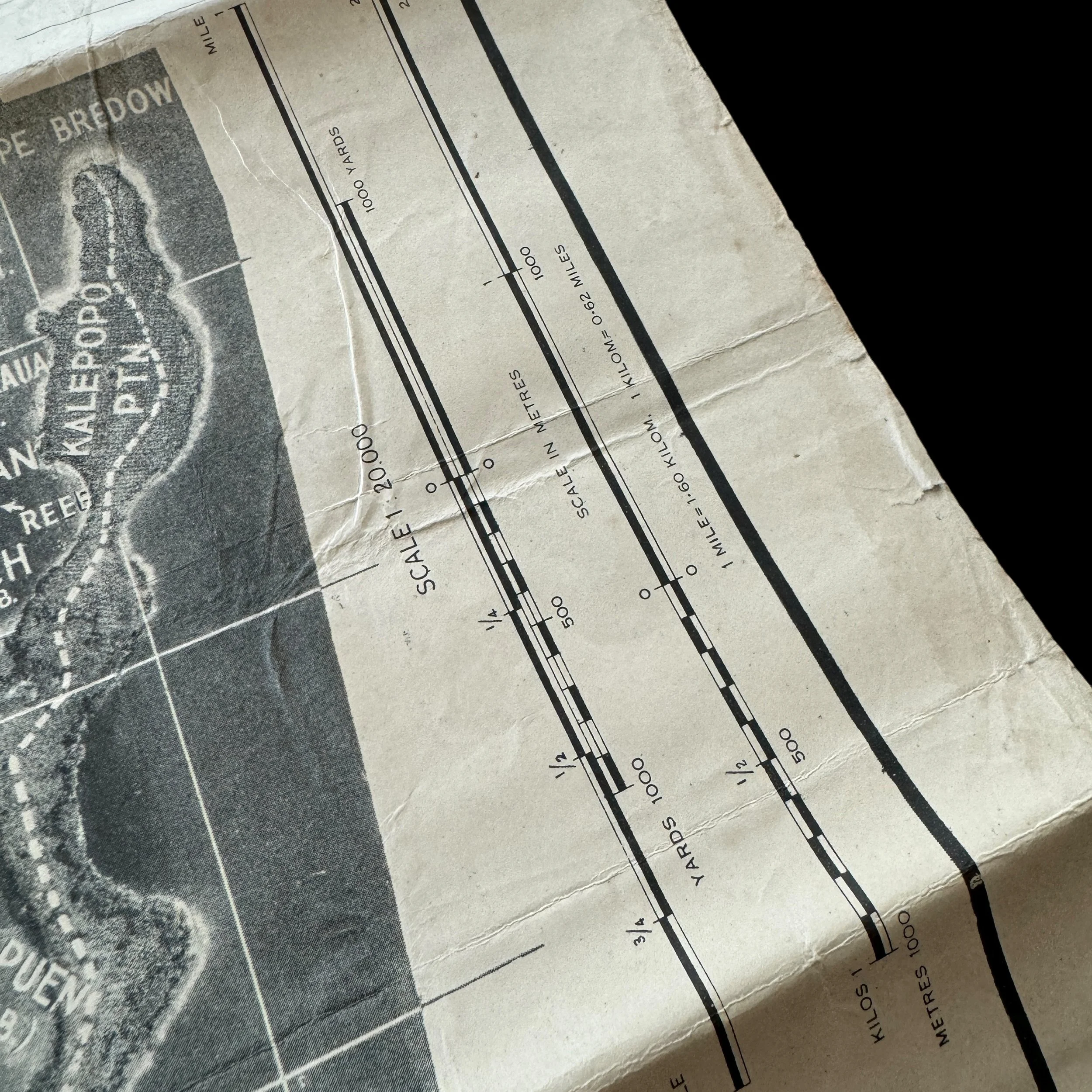
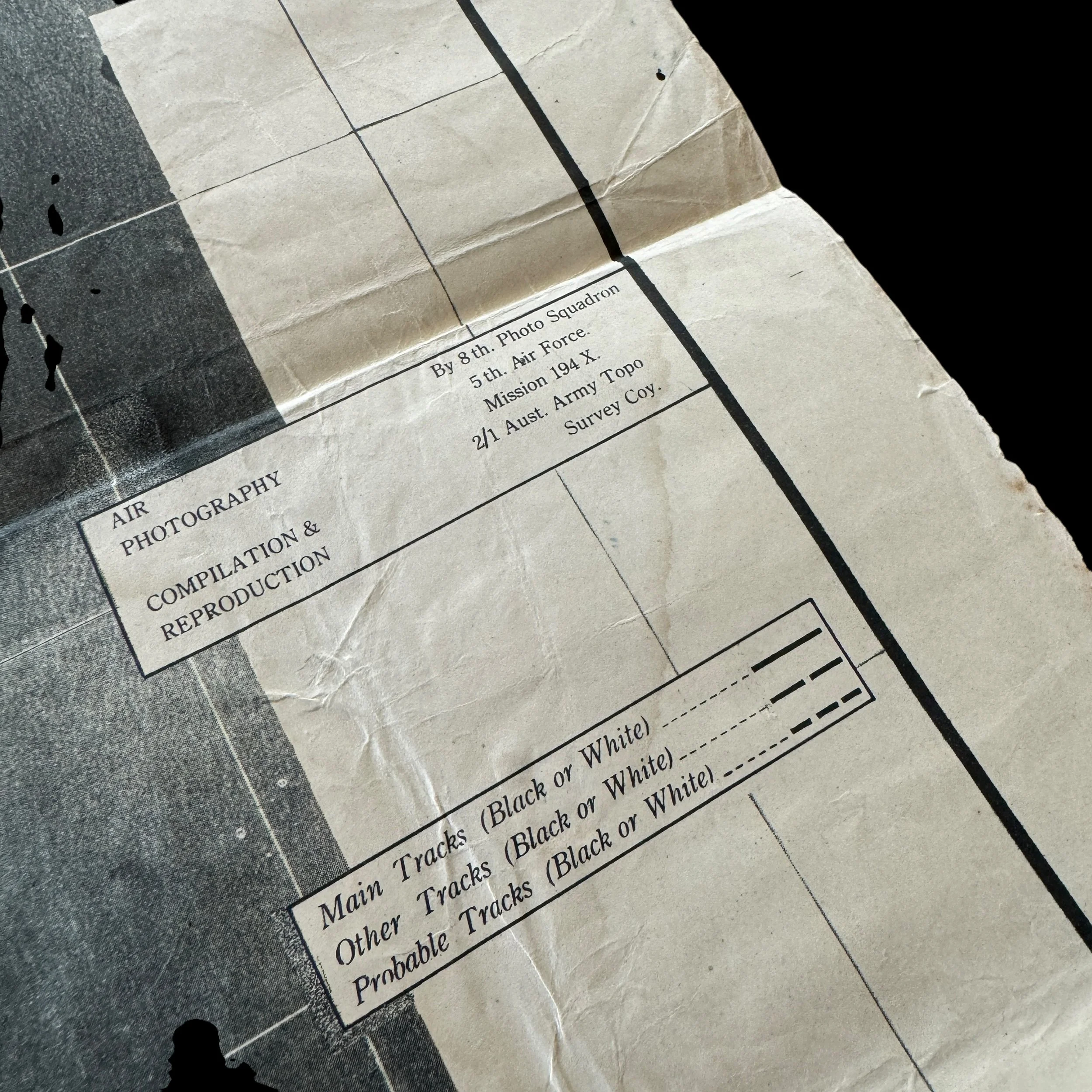
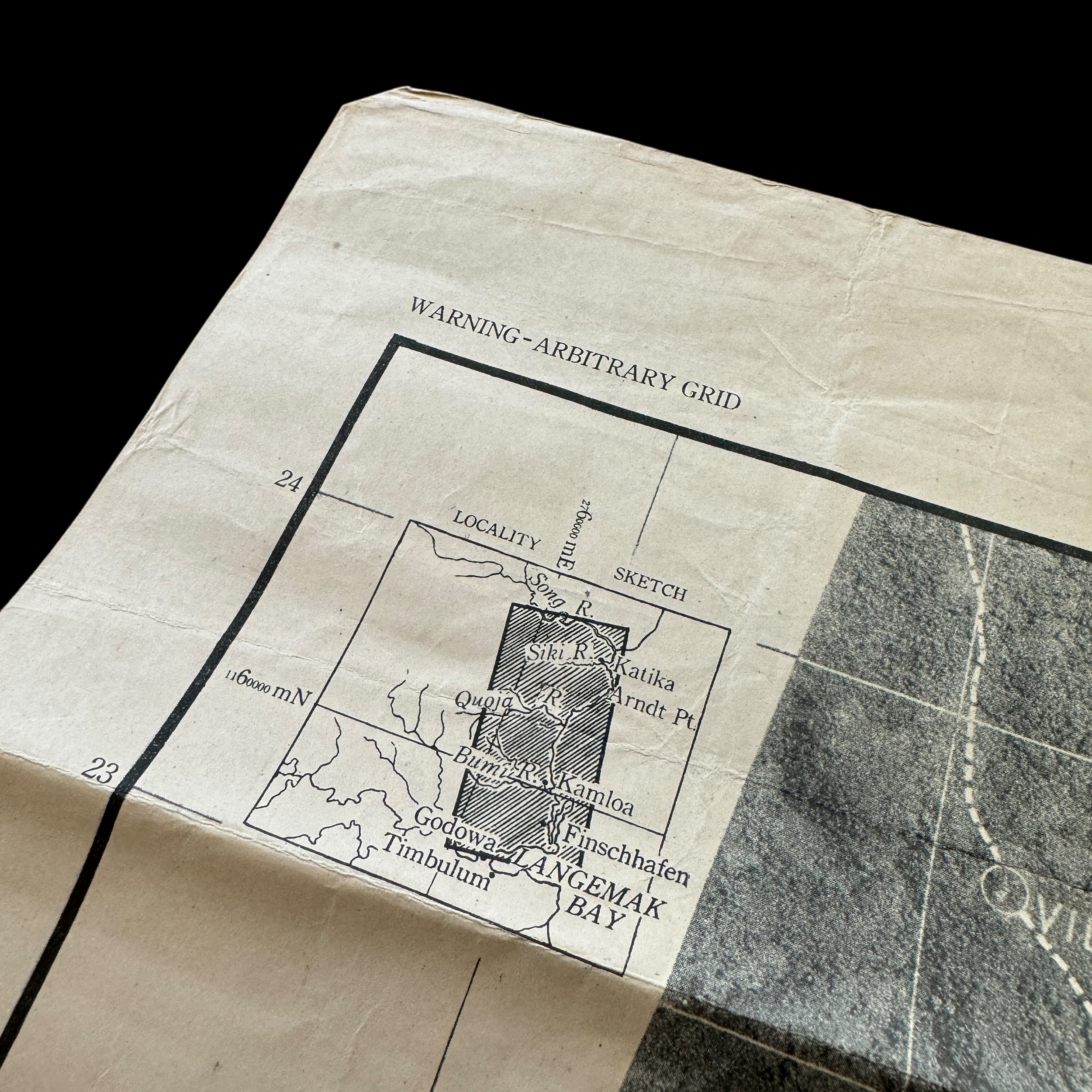
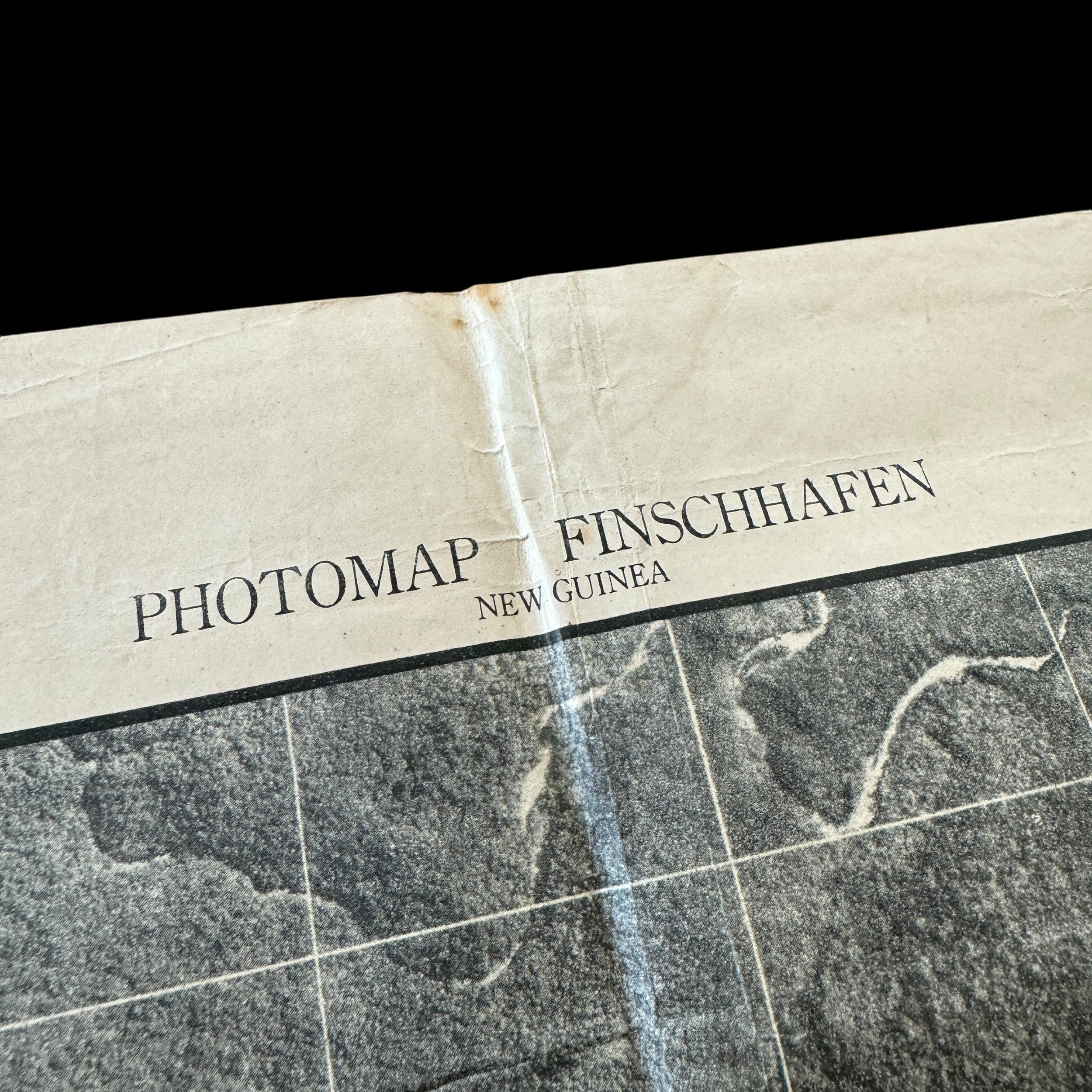
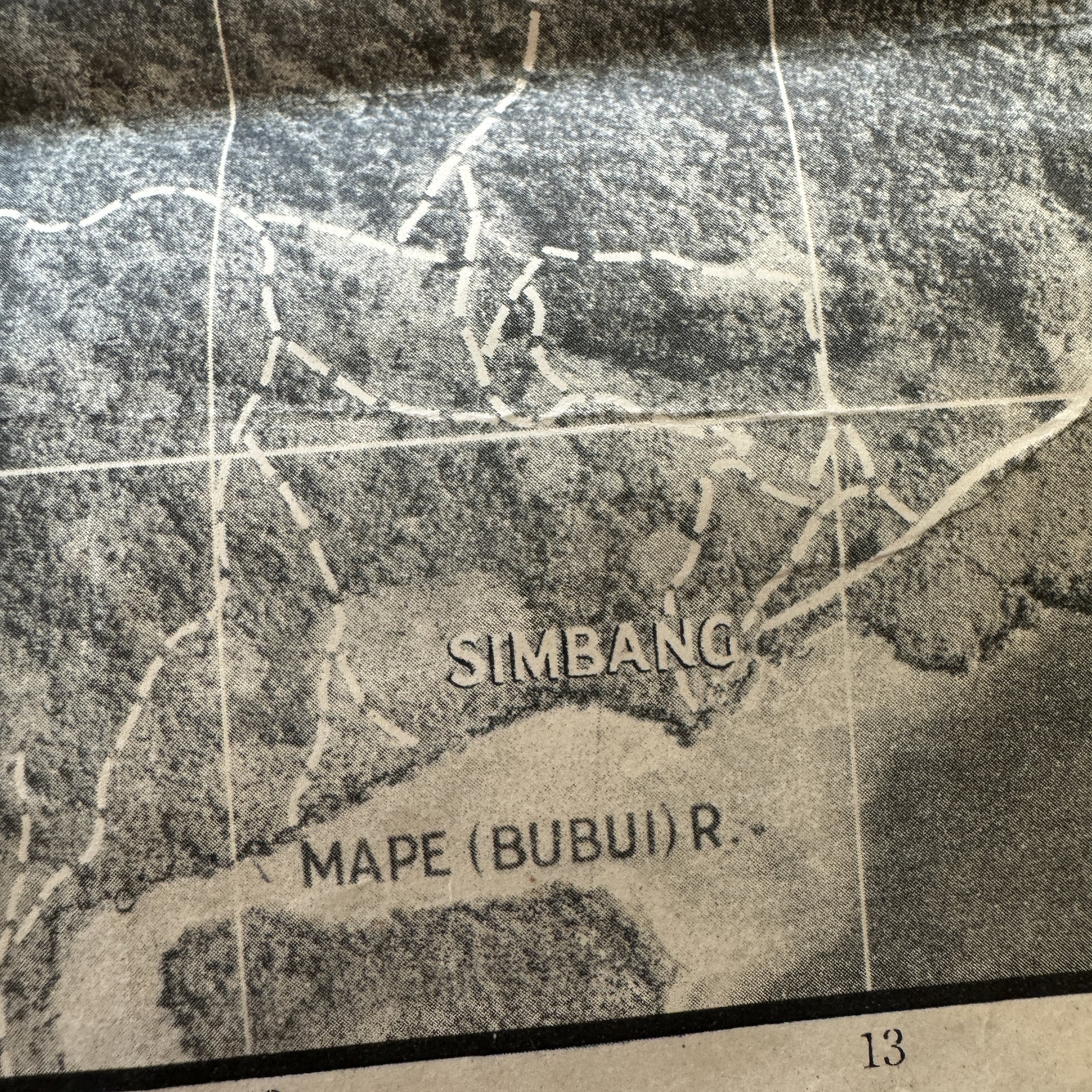


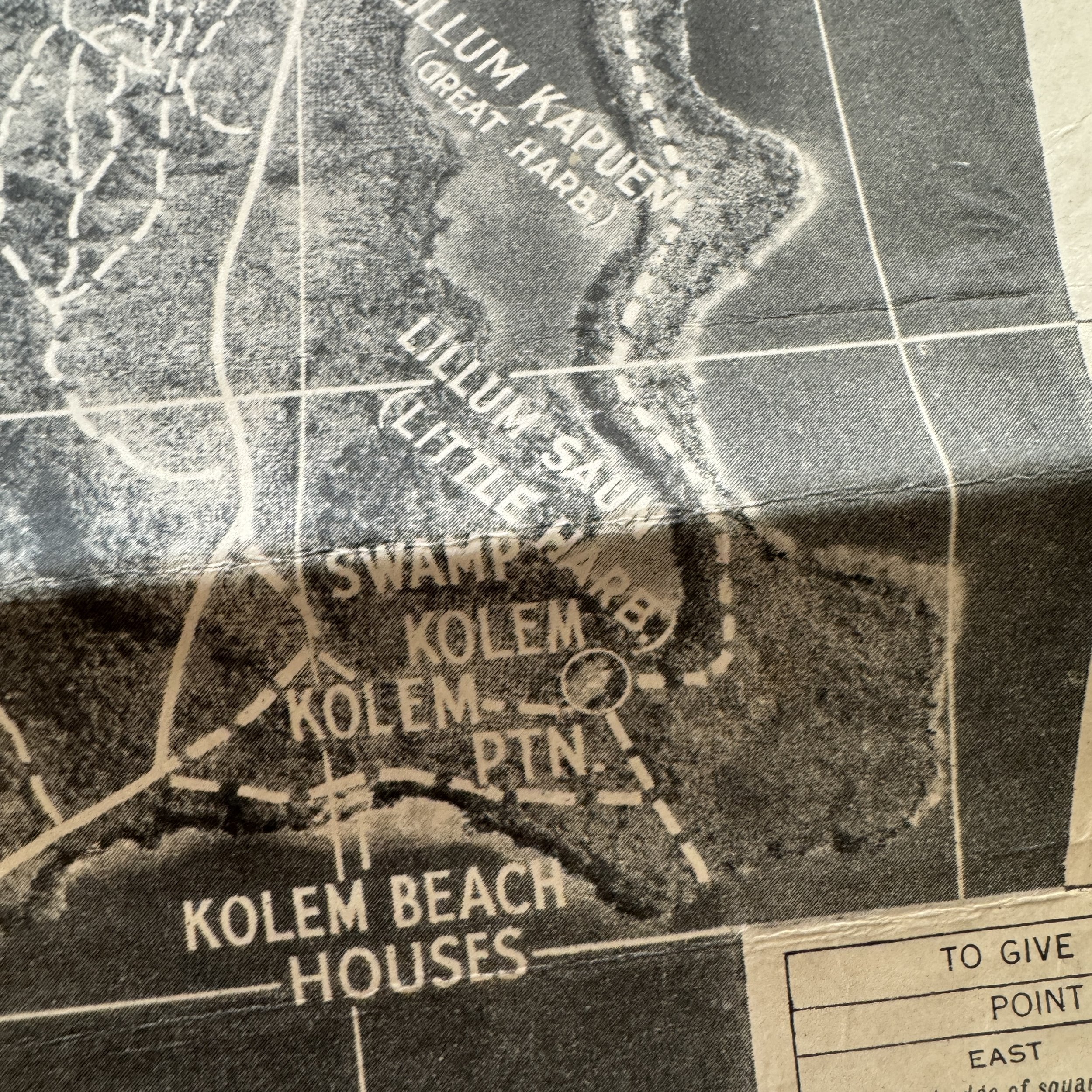
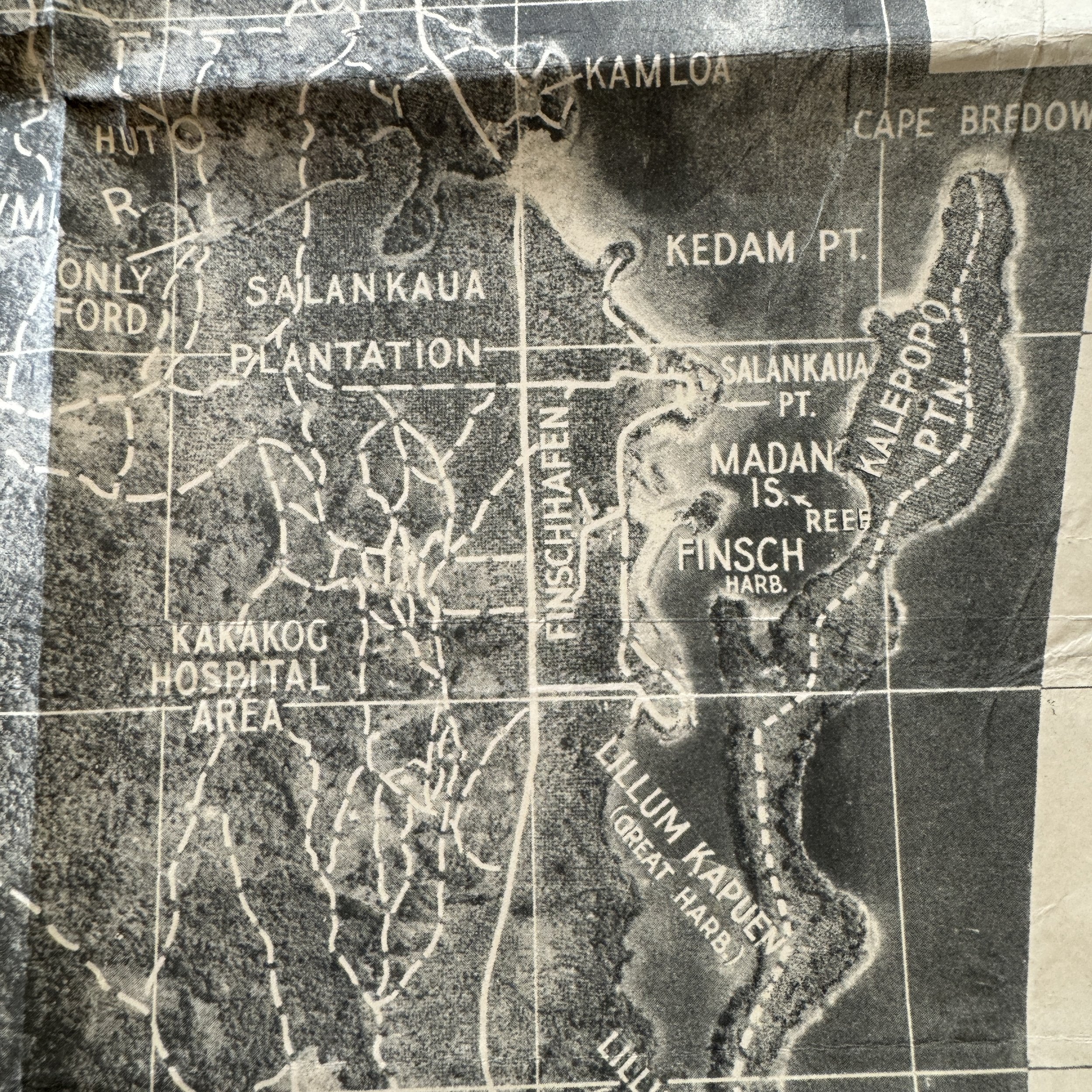
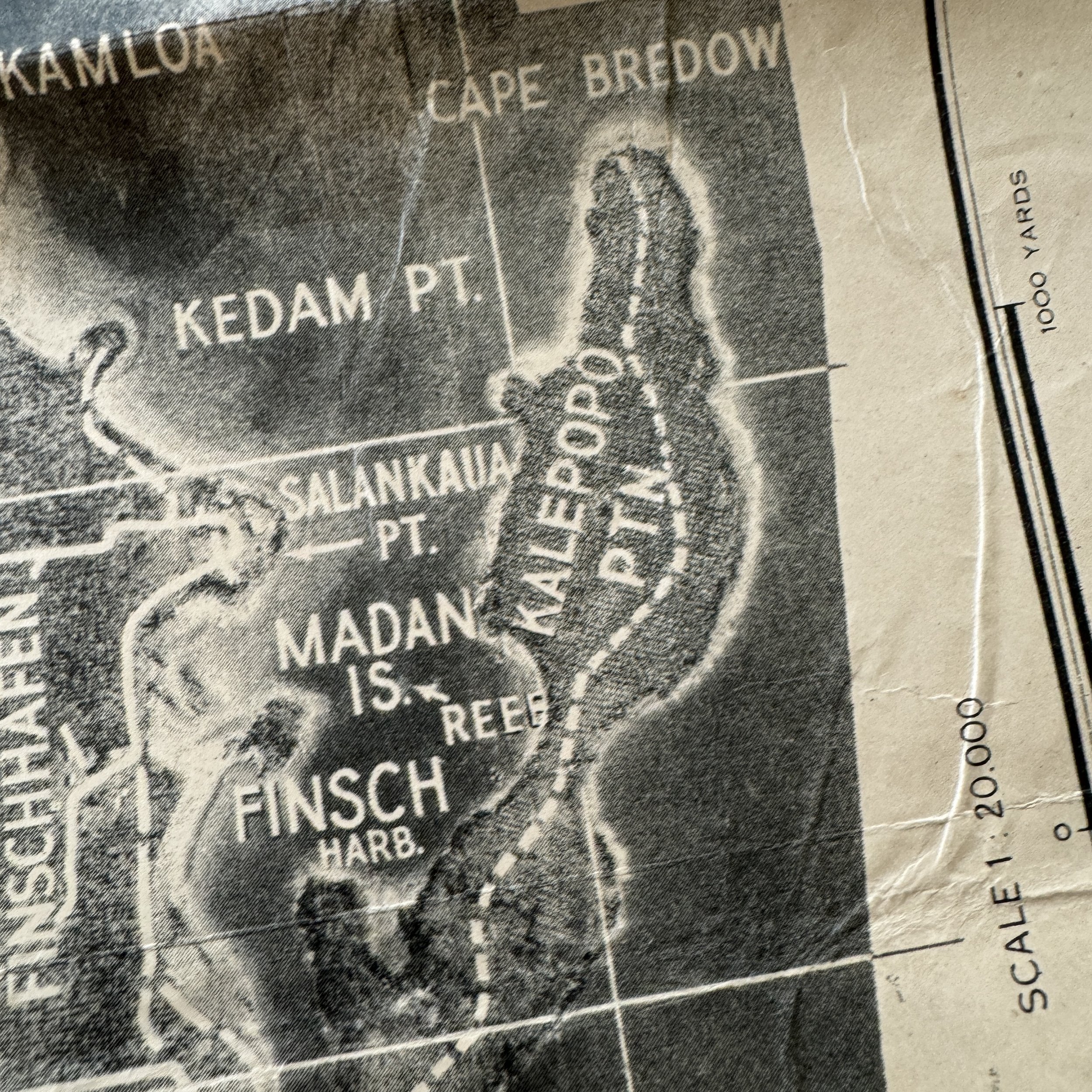
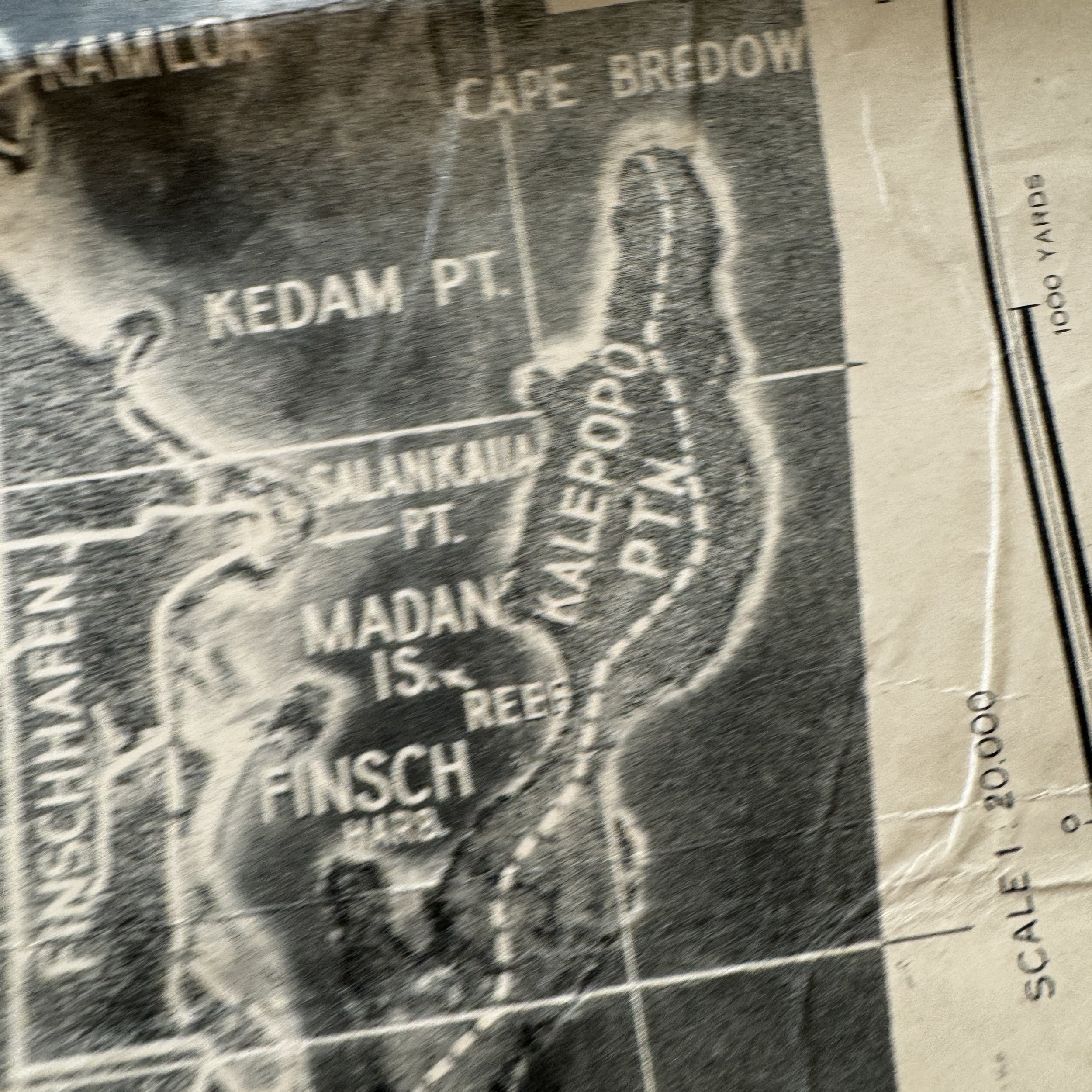


RARE! WWII 1943 Operation Postern New Guinea Campaign 8th Photo Reconnaissance Squadron (5th Air Force) Heavily Used Finschhafen & Kedam Point Combat Aerial Photo Map
Comes with a hand-signed C.O.A.
*This New Guinea combat map is a part of a larger 8th Photo Recon Squadron bring-back collection of TYPE-ONE mission photographs (the same used to make these combat maps) as well as original Allied combat maps used during the New Guinea campaign.
Size: 17 × 31 inches
This extremely rare and museum-grade Pacific Theater WWII artifact is an original 1943 dated and heavily combat-used New Guinea photomap that was created using aerial photo reconnaissance mission photographs by the infamous 5th Air Force - 8th Photo Reconnaissance Squadron (Eight Ballers).
The 8th PRS, also known as the 8th Photo Reconnaissance Squadron, earned a renowned reputation for its exceptional service during campaigns across various regions including the East Indies, Japan, China, Papua, Guadalcanal, New Guinea, Northern Solomons, and Bismarck.
The 8th Photographic Reconnaissance Squadron (8th PRS) operated under the U.S. Army Air Force (USAAF), specifically part of the 5th Air Force and the 6th Photographic Reconnaissance Group (6th PRG). Referred to as the 8th Photographic Squadron, 8th Photo Recon Squadron, or 8th Photo Recon, the unit was initially outfitted with the F-4 Lightning, a specialized photographic reconnaissance variant of the P-38 Lightning. Camera equipment was installed in the nose section in lieu of traditional armaments. Conducting missions above Japanese-held territories and airfields, the squadron captured vital imagery utilized in the creation of aerial maps and target intelligence for subsequent combat operations. These reconnaissance flights were inherently perilous, with pilots often flying solitary missions through adverse weather conditions and challenging navigation circumstances. While over target areas, pilots maintained a steady flight path at lower altitudes to ensure high-quality photographic results, braving risks such as anti-aircraft artillery and potential interception by enemy planes. In later operations, F-4s received protective escort by armed P-38 Lightnings to enhance their defensive capabilities.
________________
The Strategic Importance of Finschhafen
The Japanese occupation of Finschhafen in March 1942 marked a critical step in their push to expand throughout the South Pacific. For the Allies, Finschhafen represented an essential foothold in New Guinea due to its proximity to the Vitiaz and Dampier Straits, through which shipping routes to the Solomon Islands and northern New Guinea passed. Controlling Finschhafen allowed the Allies to cut off Japanese supply lines, threaten nearby Japanese bases, and establish a crucial airfield for operations further into the Pacific.
The Battle for Finschhafen
The Allied assault on Finschhafen began on September 22, 1943, as part of Operation Postern. Australian forces, primarily from the 9th Division, launched an amphibious landing at Scarlet Beach, approximately six miles north of Finschhafen. They faced fierce resistance from Japanese forces entrenched around the Finschhafen area and its strategic points. Among the most significant objectives was Finschhafen Airfield, which would provide the Allies with critical air support and a base for bombing raids against Japanese positions.
Despite difficult terrain and staunch Japanese resistance, the Australians advanced methodically, using a combination of artillery bombardments, air strikes, and infantry assaults. Finschhafen Airfield was captured within days of the initial landings, though Japanese forces continued their attempts to retake it. The control of the airfield significantly enhanced the Allied ability to provide air support to ground operations, delivering both supplies and reinforcements while conducting reconnaissance and strafing missions to disrupt Japanese supply routes and reinforcements.
Kedam Point and Salankaua Plantation
Kedam Point, located to the west of Finschhafen, played a vital role in securing the harbor, as it overlooked both the coastline and the approaches to Langemak Bay. Australian troops encountered heavy resistance here, with Japanese forces strategically positioned in fortified bunkers and natural caves that proved challenging to clear. The capture of Kedam Point required fierce combat and close-quarters fighting, as Australian forces had to flush out entrenched Japanese defenders to ensure safe passage for ships entering Finschhafen Harbor.
The Salankaua Plantation, situated along the coast, became a focal point for Allied advances as the Australians sought to deny the Japanese access to the area’s natural resources, which could have supported Japanese logistics efforts. The dense jungle and plantation terrain made visibility poor, allowing Japanese soldiers to utilize guerrilla tactics effectively, harassing Australian forces from concealed positions. Clearing the Salankaua Plantation required meticulous and cautious tactics, with Australian troops employing scouts, grenades, and close coordination with artillery units to secure this strategic area.
Langemak Bay
Langemak Bay became a lifeline for the Allied forces in Finschhafen, serving as a protected anchorage for supply ships and troop transports. The capture and control of Langemak Bay were critical for sustaining the Allied forces in the area. As the battle for Finschhafen raged, Langemak Bay was subjected to air raids and artillery attacks from Japanese forces, who sought to disrupt Allied logistics and delay the push toward Madang and the remainder of Japanese-held New Guinea. However, the bay’s sheltered position allowed the Allies to continue supplying troops with minimal disruption, bolstered by anti-aircraft defenses positioned along the coast.
________________
During World War II, combat photomaps were a vital tool for planning and executing military operations, particularly in challenging terrains like those found in the South Pacific, including New Guinea. Photomaps were created using aerial reconnaissance photographs combined with traditional cartographic techniques, providing highly accurate and detailed visual maps of terrain, structures, vegetation, and potential enemy positions. These maps were especially important in areas like New Guinea, where dense jungles, rugged mountains, and poorly charted territories made traditional navigation and planning extremely difficult.
The Strategic Importance of Photomaps in New Guinea
New Guinea was a key battleground in the Pacific Theater, as both Allied and Japanese forces sought control over the region due to its strategic proximity to Australia and critical supply routes. The dense jungle terrain and steep mountains made conventional maps inadequate, so photomaps became indispensable. These maps gave Allied forces a strategic advantage, as they could accurately pinpoint natural obstacles, river crossings, potential landing zones, and enemy fortifications—information that was crucial for planning ambushes, supply drops, and coordinated assaults.
In New Guinea, Allied forces needed to identify and navigate through uncharted jungle terrain, plan airstrikes, and locate Japanese supply lines and bases hidden in natural cover. Photomaps allowed military leaders to accurately identify these critical areas, providing vital intelligence for tactical planning. Allied forces used photomaps extensively in key operations, such as the capture of the Kokoda Track, the Buna-Gona campaign, and the Battle of Wau, where knowledge of terrain often determined the outcome of engagements.
The Creation and Use of Photomaps
Photomaps were produced by taking multiple high-resolution aerial photographs, often from reconnaissance planes flying at high altitudes. These photographs would then be stitched together to create a detailed composite of the area. The accuracy of photomaps depended heavily on the quality of the photographs and the skill of the cartographers who aligned them. In New Guinea, challenging weather conditions, such as tropical storms, heavy cloud cover, and mountainous terrain, complicated aerial photography, making photomap creation a demanding task that required patience and precision.
Once photomaps were created, they were distributed to field commanders, pilots, and ground troops. These maps allowed soldiers to plan their approach routes, identify enemy defenses, and navigate difficult terrain without the need for detailed topographic maps, which often weren’t available or were outdated. For example, in the Battle of Buna-Gona, photomaps enabled Allied forces to pinpoint Japanese bunkers, hidden artillery positions, and supply trails that would have been invisible in standard maps or field reports. This level of detail was critical in planning precise airstrikes and ground movements, which were essential in securing victory in such a complex environment.
Impact on Air and Ground Operations
Photomaps were especially useful in coordinating air and ground operations. The Royal Australian Air Force (RAAF) and the United States Army Air Forces (USAAF) used photomaps to identify bombing targets, enemy fortifications, and supply depots. Bombers could plan their approach routes and targeting patterns based on detailed topography provided by photomaps, reducing the risk of collateral damage and improving the success rate of airstrikes. During the Battle of Wau, for instance, photomaps allowed Allied pilots to navigate through dense cloud cover and steep mountain ranges to deliver much-needed supplies and reinforcements to Allied forces engaged in battle.
For ground forces, photomaps were invaluable in planning amphibious landings and troop movements across challenging terrain. Troops could avoid natural barriers such as swamps, cliffs, and rivers, and identify more accessible routes through dense jungle areas. This knowledge allowed for more efficient movement and positioning of forces, helping troops to maintain the element of surprise in their engagements with Japanese forces.
In amphibious operations, such as those around Lae and Salamaua, photomaps helped commanders choose landing sites that offered cover and proximity to key objectives. The maps provided enough detail to allow for effective coordination between infantry, artillery, and air support units, maximizing the efficiency of Allied assaults on Japanese-held positions.
Legacy and Influence
The use of photomaps in New Guinea marked a turning point in military cartography, establishing photoreconnaissance as a critical component of modern warfare. These maps set a new standard for military intelligence and planning, showcasing the potential of aerial reconnaissance to provide real-time data and highly accurate visual information. The success of photomap-based operations in New Guinea helped influence the development of satellite imagery and geospatial intelligence systems used in modern military and civilian applications.